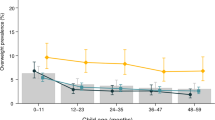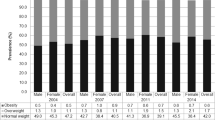Abstract
CONTEXT: The prevalence of overweight (OW) among children in the United States has increased during the last three decades, but prevalence measures fail to reveal the extent to which OW children exceed the OW threshold.
OBJECTIVE: To measure the amount by which OW children exceed the OW threshold. To examine the trend in this measure over the last three decades using data with measured weights and heights.
DESIGN, SETTING AND PARTICIPANTS: Data used for analysis are from the National Health and Nutrition Examination Survey (NHANES) for persons between 2 and 19 y of age from 1971 to 2000. Anthropometric measures were obtained by trained health technicians, and the sample sizes range from 4037 in 1999–2000 to 10 590 in 1988–1994.
MAIN OUTCOME MEASURE: The extent of OW is measured as the average amount by which each child's body mass index (BMI) exceeds their age and gender-specific OW threshold. This measure is examined by sex, age group and race/ethnicity. The OW threshold for those aged 2–19 y is defined as at or above the 95th percentile of the sex-specific BMI for age growth charts.
RESULTS: The extent of child OW has been increasing faster than the prevalence of child OW for all classifications considered in this paper, including the analysis by age, sex, race and ethnicity. The prevalence of OW for children aged 2–19 y increased by 182% between 1971–1971 and 1999–2000, while the extent of OW increased by 247% over the same time period.
CONCLUSIONS: Unlike prevalence measures, the measure of the extent of child OW is sensitive to changes in the BMI distribution of the overweight. This analysis reveals that not only have more children become OW in the last three decades, but OW children have been getting heavier.
This is a preview of subscription content, access via your institution
Access options
Subscribe to this journal
Receive 12 print issues and online access
$259.00 per year
only $21.58 per issue
Buy this article
- Purchase on Springer Link
- Instant access to full article PDF
Prices may be subject to local taxes which are calculated during checkout
Similar content being viewed by others
References
Ogden CL, Flegal KM, Carroll MD, Johnson CL . Prevalence and trends in overweight among US children and adolescents, 1999–2000. JAMA 2002; 288: 1728–1732.
Dietz WH . Health consequences of obesity in youth: childhood predictors of adult disease. Pediatrics 1998; 101: 518–525.
Power C, Lake JK, Cole TJ . Measurement and long-term health risks of child and adolescent fatness. Int J Obes Relat Metab Disord 1997; 21: 507–526.
Must A, Strauss R . Risks and consequences of childhood and adolescent obesity. Int J of Obes Relat Metab Disord 1999; 23: S2–S11.
Serdula MK, Ivery D, Coates RJ, Freedman DS, Williamson DF, Byers T . Do obese children become obese adults? a review of the literature. Prev Med 1993; 22: 167–177.
Guo SS, Roche AF, Chumela WC, Gardener JD, Siervogel RM . The predictive value of childhood body mass index values for overweight at age 35 y. Am J Clin Nutr 1994; 59: 810–819.
US Department of Health and Human Services. The surgeon general's call to action to prevent and decrease overweight and obesity. US Department of Health and Human Services, Public Health Service, Office of the Surgeon General: Rockville, MD; 2001.
Allison D, Fontaine K, Manson J, Stevens J, Vanltallie T . Annual deaths attributable to obesity in the United States. JAMA 1999; 282: 1530–1538.
Kuczmarski RJ, Ogden CL, Guo SS, Grummer-Strawn LM, Flegal KM, Mei Z, Wei R, Curtin LR, Roche AF, Johnson CL . 2000 CDC growth charts for the United States: methods and development. Vital Health Stat 2002; 11: 1–190.
Willett WC, Dietz WH, Colditz GA . Guidelines for healthy weight. N Engl J Med 1999; 341: 427–434.
Kenchaiah S, Evans JC, Levy D, Wilson PW, Benjamin EJ, Larson MG, Kannel WB, Vasan RS . Obesity and the risk of heart failure. New Engl J Med 2002; 347: 305–313.
Kurth T, Gaziano M, Berger K, Kase C, Rexrode K, Cook N, Buring J, Manson J . Body mass index and the risk of stroke in men. Arch Intern Med 2002; 162: 2557–2562.
Flegal K, Troiano R . Changes in the distribution of body mass index of adults and children in the US population. Int J of Obes Relat Metab Disord 2000; 24: 807–818.
Jolliffe D, Semykina A . Robust standard errors for the Foster–Greer–Thorbecke class of poverty indices: SEPOV. Stata Technical Bulletin 1999, STB–51.
Kish L, Frankel M . Balanced repeated replications for standard errors. J Am Stat Assoc 1970; 65: 1071–1094.
Acknowledgements
I thank Jay Variyam, Fred Kuchler, Josh Winicki, Alison Jacknowitz, and two anonymous referees for comments and help. The views and opinions expressed in this paper do not necessarily reflect the views of the Economic Research Service of the US Department of Agriculture. I am fully responsible for the contents of this note and any errors it may contain.
Author information
Authors and Affiliations
Corresponding author
Rights and permissions
About this article
Cite this article
Jolliffe, D. Extent of overweight among US children and adolescents from 1971 to 2000. Int J Obes 28, 4–9 (2004). https://doi.org/10.1038/sj.ijo.0802421
Received:
Revised:
Accepted:
Published:
Issue Date:
DOI: https://doi.org/10.1038/sj.ijo.0802421
Keywords
This article is cited by
-
Obesity in prematurely born children and adolescents: follow up in pediatric clinic
Nutrition Journal (2013)
-
Nutrition in calcium nephrolithiasis
Journal of Translational Medicine (2013)
-
Evolution of obesity in a low birth weight cohort
Journal of Perinatology (2012)
-
Bariatric surgery decision making challenges: the stability of teens’ decisions and the treatment failure paradox
Pediatric Surgery International (2012)
-
Screen-time Weight-loss Intervention Targeting Children at Home (SWITCH): A randomized controlled trial study protocol
BMC Public Health (2011)



